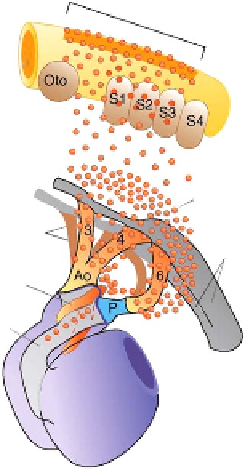Biology Reference
In-Depth Information
Neural tube
Circumpharyngeal
crest
Lumen of
aortic arch arteries
Lumen of right and left
dorsal aorta
Aorticopulmonary
septum
Lumen of
conotruncus
Figure 3.30
Migration and distribution of cardiac NCCs from their origin to the caudal
pharynx and from there into the outflow tract.
Source
: From
Hutson and Kirby (2007)
.
evolutionary transition from fish into amphibians and the evolutionary reversion of
that ability in amniotes (reptiles, birds, and mammals) (
Lee and Saint-Jeannet, 2011
).
Vasculogenesis and Angiogenesis
It is a well-established observation in anatomy that blood vessels do not form ran-
domly and are closely associated with peripheral nerves. Only recently have biolo-
gists begun to figure out a possible causal relationship between the two. Beginning
in the mid-1990s, a group of five VEGFs was reported to play a role in vasculo-
genesis (
Carmeliet et al., 1996
), proliferation of vasculoendothelial cells (
Ash and
Overbeek, 2000
), and directed migration of endothelial cells (
Esser et al., 1998
).
Mukoyama et al. (2002)
presented direct experimental evidence on the role of the
nervous system in angiogenesis: mice lacking sensory nerves in limbs develop large
vessels that branch directly into small vessels rather than in normal intermediate ves-
sels. It turned out that sensory neurons during development secrete VEGF, regulat-
ing both the arterial differentiation and branching on nerve templates (
James and
Mukouyama, 2011; Mukoyama et al., 2002
; see
Figure 3.31
). This vasculogenetic
function of the peripheral nerves seems to explain the causal basis between the asso-
ciation of nerves and blood vessels.

Search WWH ::

Custom Search